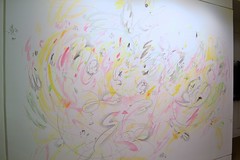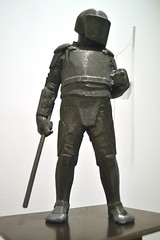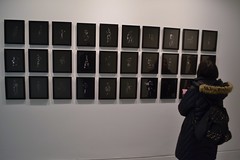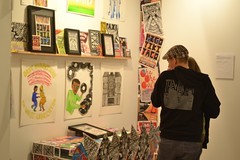Opened on March 6, 2015
Noting that the Spanish name for Philadelphia, Filadelfia, is similar in spelling and sound but implies a foreign perspective, this exhibition highlights the views of a select group of eight Latino artists living in the city. Working in installation, sculpture, video, photography, and quasi-relational aesthetics, these artists check their connections to places and objects, social markers and urban environments, the nature and relationship of power in society, and the role of history and migration in shaping identity. Informed and formed by their distinct histories and experiences, these artists share their vision and offer us New Perspectives.

Grimaldi Baez, a Puerto Rican born artist from Massachusetts, crayon and pencil wall drawing Anatomy of a Handsome Sailor (2015) can be viewed as a statement to his virtuosity as a draftsman and to the flirtations of his youth. Made with spiraling humor and whimsy it echoes with familiar characters the imagination of childhood. We see in the wall the vestiges of Kilroy, Popeye, Mickey Mouse and the crawling of ants like ripples of memory, and yet through the layered spirals in yellow and blue we also note the adult mind at work linking the seemingly arbitrary lines like a long string of thoughts into fleeting ideas. But to Baez, the work represents a record of the four hours it took for him to put this together, lost in the mechanical process of drawing and in the background sound of jackhammers pounding the street.
Yet, in further analysis Baez acknowledges in his description of the work the greater complexity of his creation,  that there are elements to âloveâ and to âstudyâ and admire in what may other wise be a âgeneric man.â Once the exhibition is over, the work will be painted over and it will become memory with its traces outlined in documentation and anecdotes.

With the field song and rhythmic sound of slashing and hacking we come to Roxana Perez-Mendezâs Cortando Caña II (Cutting Cane II) (2014), a single channel video installation with air plants.  The video installation uses an old theater trick called the Pepperâs Ghost Hologram, which uses mirrored two-way glass that when standing directly in front of the work creates a three dimensional effect. In this work we see multiples of the same woman cutting and slashing stalks of cane that are represented by the air plants. The âwomenâ are toiling in the black field of the screen while a Spanish hymn hauntingly plays in the background, Psalm 29, as if in prayer for deliverance from the back-breaking work and a difficult life. Standing before this holographic work that almost slips into reality the viewer is forced to bear witness to what must be the daily drudgery of their life. Yet, in their faces and movements exists an inner strength and resilience.
Perez-Mendez is an artist whose work focuses on the experiences that shape immigrant identity that she sees specifically through her lens as a Puerto Rican woman. In her work she puts herself as a protagonist, embodying the pain and challenges of the people she depicts. The audience is always implicated, forced by the method of her technique to stand just so to appreciate the circumstances of those she is “embodying” and maybe just wonder what they can do.

Mark C. Martinez as both a Korean and Puerto Rican-American artist is also interested in exploring the power of identity in shaping perceptions.  His work, though, is both abstract and concrete, referring to objects and images that permeate his life and memory.  In his three-dimensional work for the show, Hinesville, GA to Philadelphia, PA (2015), he brings elegantly these references to bear. In the form of a three-panel screen he evokes the memory of the divider that was in his home in Georgia. In the neon junk car signs papering the face of the divider he took from his current neighborhood, he references Latino North Philadelphia. But these signs, like the divider itself, have been internalized and transmuted by his experiences. The signs have been cut and reworked into puns, gibberish, and forms of color and light and combined with the physicality of the divider subtly imposing its presence on the viewer: forcing the viewer to walk around it in wonder of what lies behind it, or what is being hidden.
Martinez, a recent Tyler School of Art graduate, is an artist who is not only interested in the surfaces of his work but also in the way we interact with it. His artistic investigation often creates an environment that makes the viewer move through, not just see it, causing the viewer to question their relationship to his work that borders on experience. Martinez describes his process as an investigation into identity and the dynamics of power – by blending sculpture, painting, collage and decollage he aims to do so.

The realities and the power relationship between his native Puerto Rico and the United States form the basis of José Ortiz-Pagánâs current work, Exit #1 (2015). The work, made with nails and red thread to form the contours of the island of Puerto Rico with the word âExitâ neatly spelled in it, comments on the current state of affairs gripping the island: its economic troubles, the increasing migration of its citizens, and the high crime rate. For Ortiz-Pagán, the problems affecting his home, where his family lives, contrast with where he lives now, in the United States – a country that he sees as a colonizer that exacerbates Puerto Rico’s problems by  unjustly asserting its will to control the politics and freedom of his people.
Ortiz-Pagán’s aim is always to create a space in his work for conversation about what he calls âpost-industrial realitiesâ that affect the tropics. Time and power dynamics are always at play, corroding perspective and interfering with how we communicate with each other. In considering the migration aspect of Exit #1, it is as much a question he asks himself of what he is doing here as it is an expression of the situation affecting his homeland.

Where we sit in relation to power, is the focus of Miguel Antonio Hornâs two sculpture pieces Guardian I (2015) and Cajalleros (2015). Situated just over our eyesight on a slender iron pedestal, the fully armored foot-tall police officer with shield of Guardian I conveys an ominous sense of menace. It is commentary he says on the underlying question that plagues not just American society but the world in general with the increasing militarization of police forces. As an American and a Colombian/Venezuelan he recognizes a similarity in the way that police dress and conduct themselves in answer to protests in Ferguson as well as in Caracas, Venezuela. Are the police, he asks, dressed to keep peace or are they dressed to suppress dissent?  With their armor on, and the anonymity that their mask provides, that question becomes increasingly difficult to answer.
In contrast, Cajalleros, a series of cast concrete figures set across the floor of the gallery in a variety of poses from sitting to standing to lying seemingly unconscious, is of the forgotten and invisible of society. The name, cajalleros, in Spanish means people of the street. By making their faces indistinct it highlights their invisibility to us. For Horn, the use of scale is also intentional. For both series, the foot-tall size of the sculptures and the relative position to the viewer puts into relation ideas of power. To stand above the eye line, is to look down with strength; to be below the eye line is to be removed and presented as weak. The way the figures stand also conveys that persons power. Horn in these two series brings our humanity into question in the way see each other and behave.

Philadelphia-born Michelle Angela Ortiz draws from memories and personal stories in her installation Quizas Mañana Nuestro Llanto Quede Atras (Hopefully Tomorrow our Sorrow Remains Behind Us) (2012). The installation, an eight-foot square light box with  cut out outlines of a shanty, represents the home where her deaf grandfather in Puerto Rico lived and, with a looped recording of her father singing, is a meditation on family bonds and longing for something better. The work is both elegant and powerful. It tells the story of a son who although blessed with a lovely voice could not offer comfort to his father who was unable to hear. This distinction, Ortiz points out, is what alienated her grandfather from his community on the island. The song âAmor Adiosâ (Goodbye My Love; listen to it here) is what her father used to sing to his father. It is ballad of longing and of wishing that the person returns to a better time without suffering. Ortiz in her installation creates an atmosphere of sadness but one that also embodies hope and want.
Ortiz, who is a prominent muralist, is an artist who sees art as playing an active role in society. In her work, she strives to give back to communities the stories and the culture that she often sees co-opted. Finding this humanness, and sense of respect for others is where she finds her place, and in this installation it is where she hopes we find our compassion.

For the Puerto Rican born photographer Jaime Alvarez removing the relationship to objects as codified by memory is the subject of Memento (2012). Starkly photographed with black backgrounds, the color prints of small tchotchkes that he mainly bought from second-hand stores are made bereft of sentimentality with plastip – dark tinted liquid rubber. The giraffe, the angels, the little boy and other items that in homes are often imbued with sentimental value are stripped of expression. Photographed from the back the viewer is forced to question their relationship to them. Each photograph, side by side, then reflects on to the other that question of its own connection to memory and in turn our own connection to the objects.  He causes us to wonder if we really know what is in front of us: the shape of the tchotchke, its weight, or its size. The exquisite photographs in this context becomes anchors to the here and now.
Alvarez is also an installation and video artist. In his work he has paid homage to science fiction, space, and abstraction. In Memento he confronts the power of nostalgia by forcing us to see without distractions, removing light and focusing on detail.

The artist/dj/cultural event producer Juan Bustamante rounds out the exhibition with his installation Escucha la Ciudad (Listen to the City and the Tropacalismo event he is producing with his co-founder, Greg Scruggs, for Taller on March 27. With roots from Colombia and his interest in sound system culture from South America to the Caribbean and beyond and his attraction to street art, he creates exuberant events that not only  promote urban Latino culture but place them in Philadelphia’s backyard. To promote these events he creates hand drawn posters that he distributes across the city.  Working in this manner he says, brings him into direct contact with the artifacts people leave behind: from the yard sale signs to the lost cat signs, to commissioned street signs and graffiti. In these images he sees a rhythm in urban society taking shape which he reflects in his drawings and events.  As the part of the events he creates elaborate dj booths out of the hand drawn posters, postcards and ephemera he finds and which represents in his in installation at Taller.  Partnering with Scruggs, he brings us their fifth annual Tropicalismo event, a scholarly celebration of the various incarnations of Carnaval in Latin America and the world.  This will be the closing event for the Filadelfia exhibition, signifying, with his installation, the increasing influence and intermingling of a vibrant urban Latino and Caribbean culture in America.
For more information on this exhibition contact Rafael Damast at rdamast@tallerpr.org



